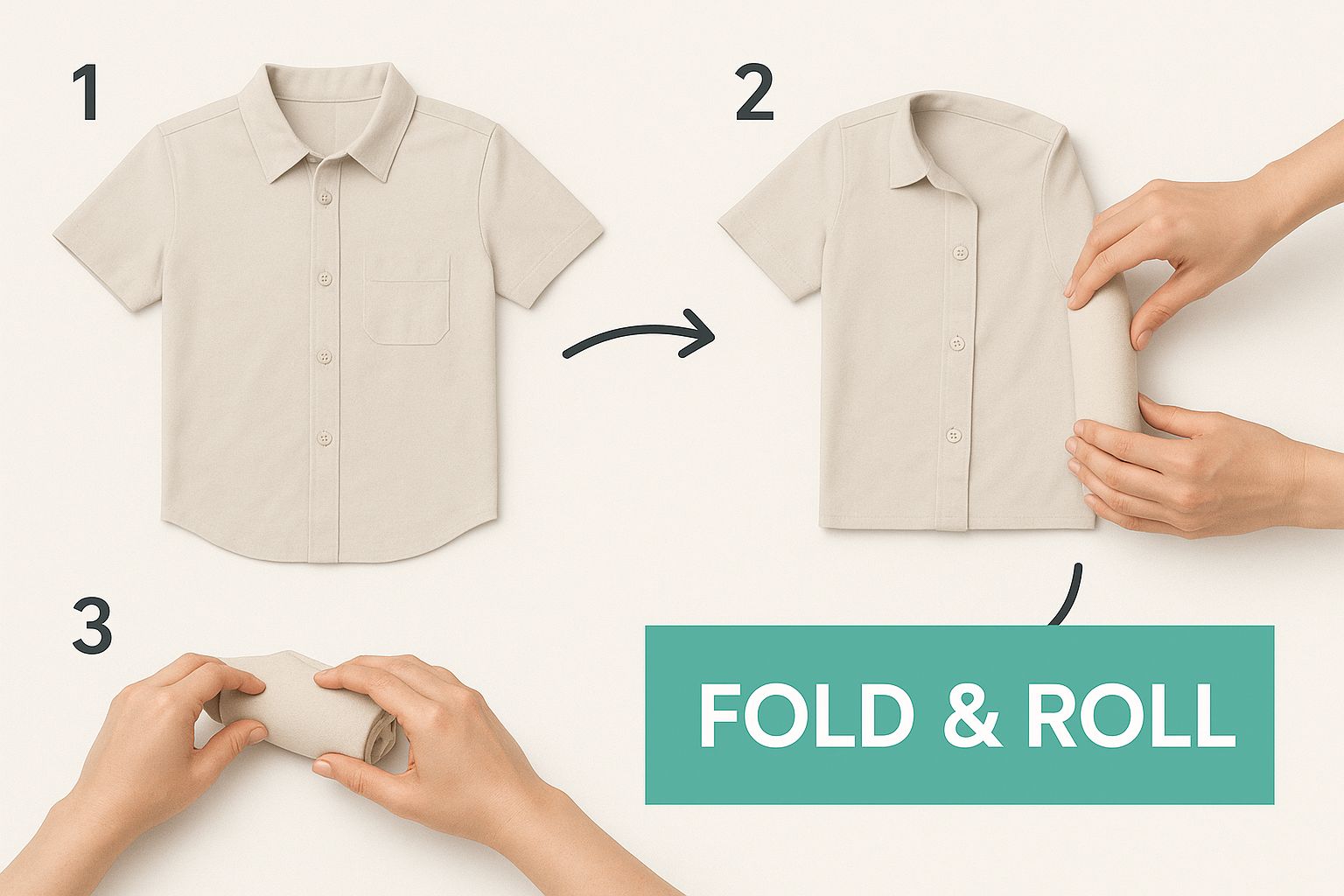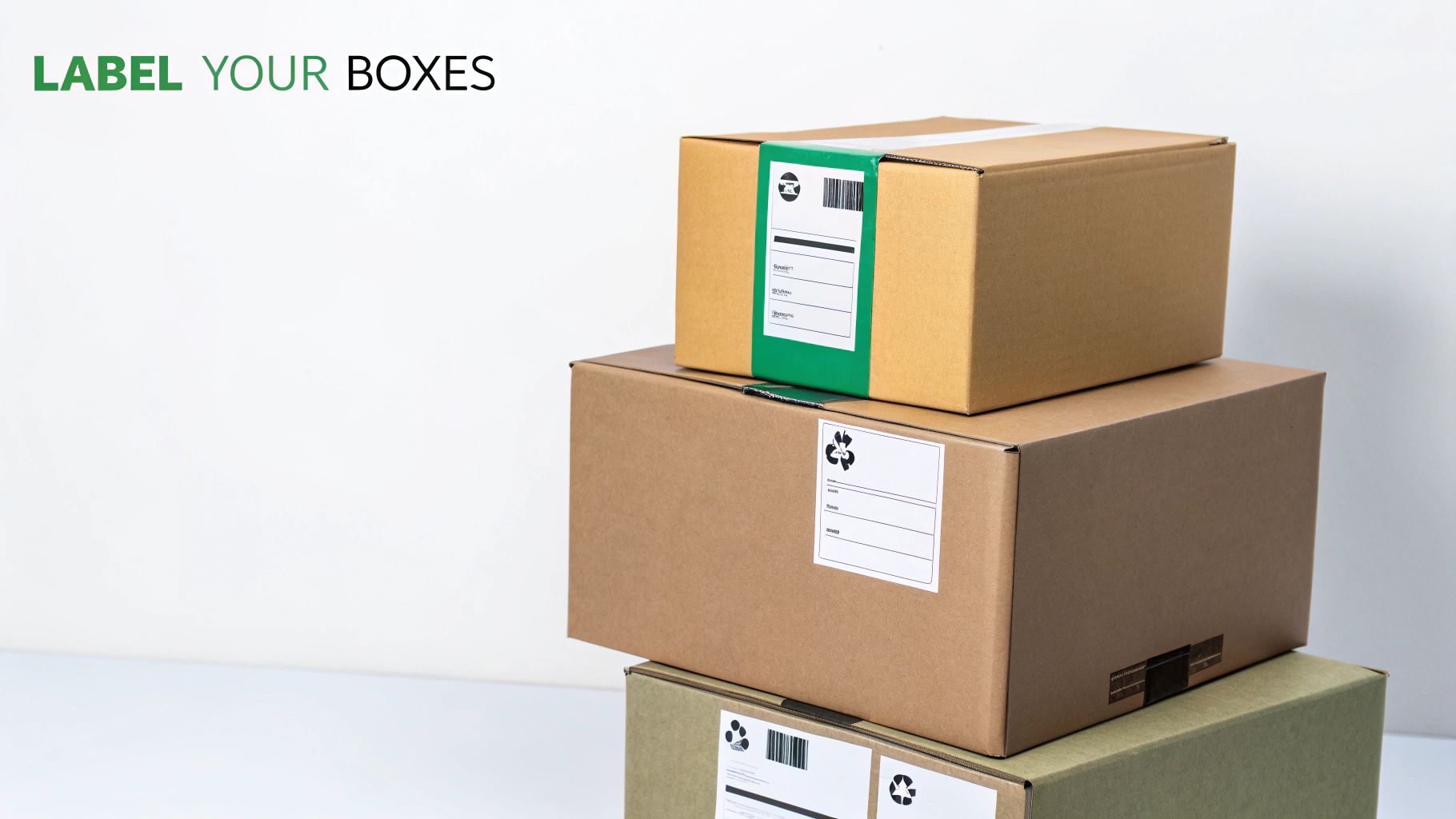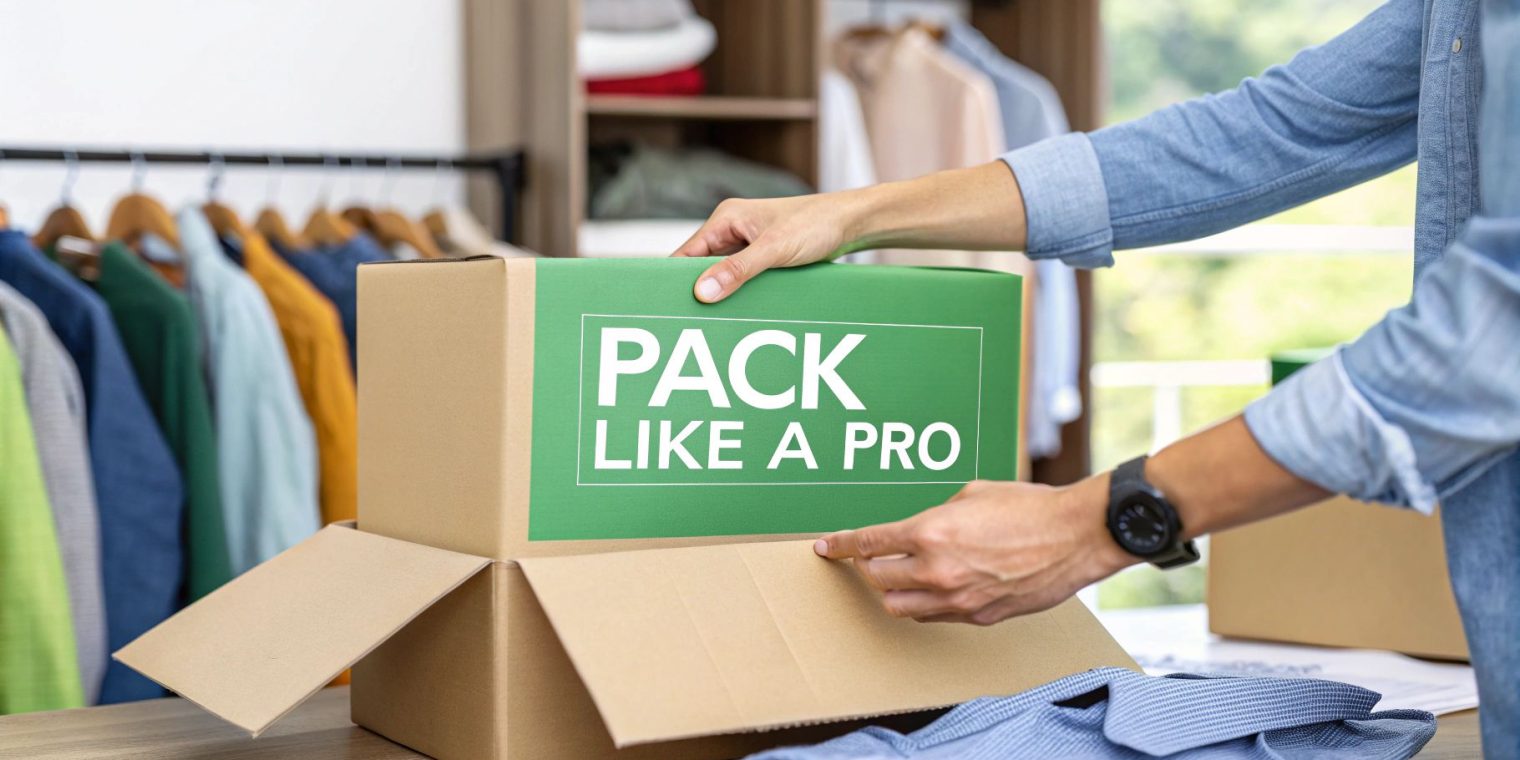If you want to know the real secret to packing clothes for a move, it’s not about some fancy folding technique. It starts way before that, with a good, old-fashioned wardrobe purge. Honestly, getting ruthless with your clothes before you touch a single box is the best thing you can do. It makes the whole process easier and can cut down your packing load by as much as 30%. You'll end up moving only the things you actually love and will wear.
Start with a Ruthless Wardrobe Purge

Before a single moving box comes out, the first, most important job is to take a hard look at everything in your wardrobe. This isn't just a quick tidy-up; it's a strategic move that will make your entire relocation simpler and cheaper. Moving less stuff means fewer packing supplies, fewer boxes to lug around, and—best of all—less to unpack when you get to your new place.
Think about what your life will look like in your new home, not what it was in your old one. This is especially true here in Australia, where we're seeing a lot of people move out of the big cities. A recent report showed that net migration to regional areas was still high, with around 40,000 people making the move in the March 2025 quarter alone—that’s a 10.5% jump in people leaving capital cities. A sea change or tree change often means a wardrobe change, so it's the perfect time to get organised.
The 'Wear, Store, Share' Framework
To stop this from turning into an overwhelming emotional drama, I always recommend the 'Wear, Store, Share' method. It’s simple. Just create three separate piles or zones in your room and sort every single piece of clothing into one of them.
- Wear: This pile is for your absolute favourites. These are the items you wear all the time, that fit you perfectly, and that you know you'll need in your new life. They’re the keepers, no question.
- Store: Here’s where you put sentimental items you just can't bear to part with, or seasonal gear you won't need right away (like that heavy winter coat if you're moving in summer).
- Share: Anything you're ready to donate, sell, or pass on to a friend goes here. Be honest. If you haven't worn it in over a year or it just doesn't fit anymore, it's time for it to find a new home.
Using this framework forces you to make a clear decision for every item. There's no "maybe" pile to agonise over and eventually just pack out of frustration.
A well-executed purge is the ultimate moving hack. It’s not just about getting rid of things; it’s about making space—physically and mentally—for your new life. You're not just clearing a closet; you're streamlining your future.
Practical Tips for a Successful Purge
Trying to tackle your entire wardrobe in one go is a recipe for disaster. I’ve seen it happen! A much better approach is to break it down into smaller, more manageable chunks. Do your tops first, then trousers, then dresses, then shoes.
As you go through each category, ask yourself a few direct questions:
- Does this actually fit me right now?
- Have I worn it in the last 12 months?
- Will I realistically wear this in my new home?
This helps you stay logical and less sentimental about the process. For some more great ideas on this, there are some excellent tips on how to declutter your closet effectively. By really committing to this first step, you're setting yourself up for a much smoother, less stressful move.
Right, you’ve sorted through your wardrobe and now it’s time to get your packing supplies in order. This is a step you don't want to rush. Honestly, having the right gear can be the difference between a smooth, organised move and a chaotic mess that leaves your favourite clothes looking like they’ve been in a wrestling match.
It’s easy to get overwhelmed by the sheer amount of moving supplies out there, but you really don't need one of everything. The trick is to be smart about it, choosing tools that will genuinely protect your clothes and make the best use of space. Sure, you can grab free boxes from the local supermarket, but they’re often flimsy and oddly shaped, which can lead to a game of Tetris in the moving truck that nobody wins.
Getting the Basics: Boxes and Bags
Let's start with the essentials—your containers. Standard cardboard boxes are the undeniable workhorses of any move. I always recommend investing in proper moving boxes. They're built to be sturdy and, crucially, they're uniform in size. This makes stacking them in the truck a breeze and far safer than a wobbly tower of mismatched boxes.
For softer items that don't need much structural protection—think t-shirts, jumpers, socks, and gym gear—heavy-duty bags can be fantastic. Even the suitcases you already own are perfect for this. They’re flexible, so you can squish them into those awkward gaps in the moving truck, making every bit of space count.
Expert Tip: Don't just grab any old box. Spending a little on quality, uniform-sized moving boxes is one of the best investments you can make. It prevents the dreaded box avalanche when you finally open the truck doors at your new place.
If you're unsure where to start looking, this guide on where to buy moving boxes is a great resource. It breaks down reliable and budget-friendly options, so you can build a solid foundation for your packing.
Speciality Supplies That Are Genuinely Worth It
While standard boxes will get you far, some clothes just need a bit more care. This is where a few specialty items can be absolute lifesavers. Knowing which ones are worth the money is key.
- Wardrobe Boxes: These are the tall boxes with a metal hanging bar across the top. For suits, dresses, blazers, or anything you don’t want crushed, these are non-negotiable. They let your clothes hang naturally during the move, which means no deep-set wrinkles to steam out later. A real game-changer.
- Vacuum-Seal Bags: Got bulky winter coats, puffer jackets, or duvets? These bags are incredible. You simply suck out all the air and can shrink items by up to 75%. It's a massive space-saver. Just remember, the bags will be surprisingly heavy and dense once sealed, so pack them accordingly.
- Garment Bags: For your absolute most prized items—a wedding dress, a tailored suit—an extra layer of protection is a good idea. A simple, breathable garment bag will shield it from dust, moisture, and snags, even inside a wardrobe box.
As you plan your move, you might also need a temporary spot for clothes you need right up until moving day. Looking into clothes rail storage solutions can be a brilliant way to keep hanging items organised. It’s also handy for setting up a temporary closet in your new home before you’ve had a chance to assemble your proper wardrobes.
Clothing Packing Method Comparison
Choosing the right packing method for different types of clothing can save you a lot of time and potential damage. Some clothes can be folded, while others demand to be hung. This table breaks down the most common methods to help you decide.
| Packing Method | Best For | Pros | Cons |
|---|---|---|---|
| Folding in Boxes | T-shirts, jumpers, jeans, casual wear. | Space-efficient; easy to stack and transport. | Can cause creasing on delicate fabrics. |
| Rolling in Bags | Soft, wrinkle-resistant items like activewear, PJs, socks. | Maximises space; fits into odd-shaped gaps. | Not suitable for formal wear; can be hard to find items. |
| Wardrobe Boxes | Suits, dresses, blazers, delicate blouses. | Prevents wrinkles and crushing; unpacking is fast. | Bulky and takes up significant truck space; more expensive. |
| Vacuum-Seal Bags | Bulky coats, ski gear, duvets, pillows. | Huge space savings (up to 75%); protects from moisture. | Creates heavy, dense bags; can cause deep wrinkles. |
| Suitcases | A mix of folded clothes, shoes, and toiletries. | Easy to transport; great for an "essentials" bag. | Limited capacity; can become very heavy. |
Ultimately, a combination of these methods is usually the most effective approach. Use wardrobe boxes for your best outfits, fold everyday items, and roll your casuals to make the most of every inch of space in the moving truck. A little planning here goes a long way.
Master Space-Saving Packing Techniques
Alright, you've got your supplies sorted. Now for the real game-changer: how you actually pack your clothes. This is where you can seriously level up your moving efficiency, saving a ton of space and keeping your stress levels in check. Let's ditch the old "shove it all in a box" method. Different types of clothing need different handling to make it to your new home in good nick.
The classic debate is folding versus rolling. Honestly, both have their moments, but knowing when to use each is the secret. For your everyday, wrinkle-resistant gear—think t-shirts, activewear, and pyjamas—rolling is the undisputed champion. It compresses the fabric, meaning you can squeeze way more into a box. It also helps you avoid those sharp, set-in creases you get from standard folding.
Maximising Space with Rolling and Folding
Ever heard of the "Ranger Roll"? It’s a fantastic trick for t-shirts and shorts. You fold the garment into a tight little cylinder that holds its shape, so it won’t unravel the second you put it in the box. This isn't just a space-saver; it also lets you see everything at a glance, so you won't be digging through piles to find that one specific top later.
But rolling isn't a one-size-fits-all solution. For your more structured items like business shirts, blazers, and dress pants, a clean, flat fold is non-negotiable. These pieces need to hold their shape, and rolling can introduce weird wrinkles and put stress on the seams. A pro tip: when folding, slip a sheet of acid-free tissue paper between the layers. It cuts down on friction and helps prevent creases, especially on delicate fabrics.
Key Takeaway: Don't just mindlessly fill boxes. Be tactical. Roll your casual clothes to maximise space and minimise wrinkles, but always flat-pack your formal and structured garments to protect their shape.
If you're looking at a mountain of clothes and the clock is ticking, calling in the pros can be a genuine lifesaver. You can find expert professional packing services in Perth that save you time and let them handle the entire job for you.
Tackling Bulky and Delicate Items
We all have them: the winter coats, puffer jackets, and chunky jumpers that eat up entire boxes. This is where vacuum-seal bags become your best friend. Sucking all the air out shrinks these bulky items to a mere fraction of their size. Just a heads-up, though—while smaller, they become quite dense and heavy. Make sure to pack them in strong boxes and spread the weight out across your load.
This image shows a really effective rolling technique that’s a bit of a hybrid, using a fold to start for better structure.

Seeing it visually really helps understand how a good roll creates a tight, easy-to-pack bundle.
Finally, your delicates—things made from silk, lace, or with beading—need a bit of extra TLC. Don't just jam them in with everything else. The best approach is to lay each piece flat inside its own garment bag or wrap it individually in tissue paper. This is your best defence against snags and other damage during the move. For anything truly precious, I'd even suggest giving it its own small, dedicated box. By tailoring your packing technique to the specific garment, you can rest easy knowing everything will arrive ready to wear.
Pack Your Wardrobe by Category
Throwing everything from your closet into a box might seem fast, but it’s a surefire way to create chaos on the other end. From experience, the smartest way to pack clothes is to group similar items together. Think like a professional organiser and tackle your wardrobe category by category.
This system does more than just keep things tidy; it means different types of clothing get the specific care they need during the move. Plus, unpacking becomes a breeze. Imagine opening a box labelled “Jumpers” and finding nothing but neatly folded jumpers, ready to go straight into your new drawers. That’s the goal.
What to Do with Your Hanging Clothes
Your hanging garments—especially things like suits, dresses, and delicate blouses—need a bit more thought. The gold standard here is the wardrobe box. These are essentially tall, reinforced boxes with a built-in hanging rail, acting as a mini portable closet. Your clothes travel upright, meaning they arrive at your new home almost completely wrinkle-free.
But let's be realistic. For a quick local move across town, you might not want to splash out on wardrobe boxes. This is where the old-school ‘bin bag trick’ is a lifesaver. Just grab a bundle of 10-15 hangers, slip a large, clean bin bag over the clothes from the bottom up, and then tie the drawstrings tightly around the hanger hooks. It's cheap, surprisingly effective, and perfect for short journeys.
Looking After Shoes and Accessories
Shoes are often tossed in last, which is a recipe for crushed footwear and scuff marks on your clean clothes. The trick is to give them their own space. Start by stuffing each shoe with balled-up socks or packing paper; this helps them keep their shape and stops them from getting squashed.
If you’ve kept the original boxes, now’s the time to use them. If not, no worries. Just wrap each shoe individually in paper and place them heel-to-toe in a dedicated small box. This simple step prevents dirty soles from soiling anything else and, most importantly, keeps pairs from getting separated.
When moving within Australia, the weight of your boxes really matters. Clothing might seem light, but it adds up fast. With a 7.7% increase in people departing Australia noted in May 2025, many are learning the hard way about weight limits, which often sit around 20-30 kilograms for shipping or luggage. Efficient packing isn’t just about space; it’s about managing weight. You can read more about these travel and migration trends from the Australian Bureau of Statistics.
And what about those smaller items that always seem to get lost or tangled? Here are a few tried-and-tested tips for your accessories:
- Belts: Instead of letting them slither around, roll each one up tightly. You can tuck them into the gaps along the sides of boxes or even inside shoes.
- Scarves: Fold or roll them neatly and keep them together in a small box or a soft dust bag. This will stop delicate fabrics from snagging on zippers or buckles.
- Jewellery: A daily pill organiser is fantastic for storing earrings and rings. To stop necklaces from becoming a tangled nightmare, try threading each one through a drinking straw.
By breaking down your wardrobe into these manageable categories, you turn a daunting chore into a simple, logical process. It’s all about protecting your belongings and setting yourself up for a smooth, organised start in your new home.
Prepare a First-Night Essentials Bag

Trust me on this one. After a long, sweaty day of hauling boxes and telling movers where to put the sofa, the very last thing you’ll want to do is tear open sealed boxes just to find a clean t-shirt and your toothbrush. This is why packing an "essentials bag" is probably the smartest thing you'll do all day.
Think of it as your personal moving-day survival kit. It’s a separate suitcase or duffel bag that travels with you in your car, not in the back of the moving truck. This single act of forward-thinking can be the difference between a frantic, chaotic first night and a relatively calm, civilised start in your new place.
Building Your Ultimate Essentials Bag
Your essentials bag should look a lot like what you'd pack for a weekend away. The whole point is to avoid cracking open a single moving box until you’ve had a chance to breathe. Everyone in the family should have their own, packed with their own necessities.
Here’s a good starting point for each person’s bag:
- A couple of changes of clothes: You'll need something comfortable for the move itself, PJs for that first night, and a fresh outfit for the next day.
- Basic toiletries: Toothbrush, toothpaste, deodorant, soap or body wash, and any must-have skincare items. A hot shower will feel like the height of luxury, I promise.
- Essential medications: Any prescription meds need to be in this bag, no exceptions. It’s also wise to throw in a basic first-aid kit with some pain relievers and plasters.
- Chargers and electronics: Don’t let your phone die! Pack chargers for your phone, laptop, or any other gadget you'll need right away.
This isn't just a golden rule for local moves. It’s a habit borrowed from seasoned travellers. For instance, recent Australian travel data showed a 10.9% jump in short-term resident returns in January 2025. Frequent flyers are experts at packing essentials into carry-on to sidestep airline weight limits and potential lost luggage. You can actually see more on these national travel and packing trends from the ABS.
Pro Tip: Keep your essentials bag in the boot of your car or a designated "do not touch" spot in the house. The whole strategy falls apart if a well-meaning mover loads it onto the truck with everything else.
Beyond the Basics: What Not to Forget
Once you have the absolute necessities sorted, think about the little comforts that will make you feel a bit more human. What will help you settle in?
This could be your favourite coffee mug and a few tea bags, a portable speaker to get some music going, or even a couple of clean towels so you’re not hunting through the linen box. When you're learning how to pack clothes for moving, preparing this bag is a crucial step that ensures you arrive with your sanity still in one piece.
Common Questions About Packing Clothes
Even the most organised person has questions pop up when it's time to pack up a wardrobe. Let's be honest, it can feel like a huge task. Getting some clear, practical answers can save you from making classic moving mistakes and make the whole thing feel a lot less overwhelming.
Over the years, we've heard it all. Here are the most common questions we get, with the straightforward advice we always give our clients.
How Far in Advance Should I Start Packing?
The golden rule here is to start with your out-of-season and rarely-used items about 3-4 weeks before moving day. Is it the middle of summer? Go ahead and pack those bulky winter jackets and woolly jumpers. That formal dress or suit you only wear for special occasions? Pack it. Getting these things boxed up early clears out space and doesn't mess with your daily routine.
This staggered approach breaks the job down into smaller, more manageable chunks. By the time you get to the final week, you'll be packing the last of your main wardrobe, leaving out only what you need for the move itself and your essentials bag. Following a structured plan, like the one in our ultimate moving checklist, is the secret to keeping the pre-move chaos to a minimum.
Key Takeaway: Start packing clothes at least three weeks before your move, beginning with items you won’t miss. This simple strategy prevents that frantic last-minute rush and keeps your daily essentials handy right up until the end.
What Is the Best Way to Move Clothes on Hangers?
How you handle your hanging clothes really comes down to the kind of move you're doing.
If you're just moving across town, the ‘bin bag trick’ is a lifesaver. It’s cheap, quick, and surprisingly effective. Just grab a bundle of 10-15 hangers, pull a large rubbish bag up over the clothes from the bottom, and then tie the drawstrings tight around the hanger hooks at the top. Easy.
But for a long-distance move, or if you're trying to protect delicate items like formal wear, suits, or silk dresses, you really should invest in proper wardrobe boxes. These are basically portable closets with a metal bar inside, so your clothes hang naturally. It’s hands-down the best way to stop them from getting crushed and deeply wrinkled during the trip.
Should I Wash All My Clothes Before Packing?
Yes. Absolutely, one hundred percent. I know it feels like just another chore on an already massive to-do list, but trust me on this one—packing clean clothes is non-negotiable. Throwing dirty or even slightly worn garments into a sealed box is a recipe for musty smells. It can also cause unseen stains from oils or sweat to set permanently.
Think of it as a gift to your future self. Imagine arriving at your new home and being able to unpack fresh, clean clothes directly into your new wardrobe. You can settle in right away instead of being greeted by a mountain of laundry. It's a huge win for a smooth, stress-free start.
How Do I Keep My Clothes Smelling Fresh?
Nobody wants to open a box and be hit with that stale, cardboardy smell. A simple trick is to tuck a few scented dryer sheets, cedar blocks, or lavender sachets into your boxes and suitcases. These little additions are great for absorbing moisture and keeping your clothes smelling pleasant.
The most critical step, though, is making sure every single item is 100% dry before it goes into a box. Even the slightest hint of dampness can lead to mildew, especially if your things are going to be in transit or storage for a while.
Ready to make your move completely stress-free? Let the experts handle the heavy lifting. Emmanuel Transport offers professional packing and moving services across Perth, ensuring every item, from your delicate clothes to your bulkiest furniture, arrives safely. Get your free, transparent quote today by visiting https://emmanueltransport.net.au.













